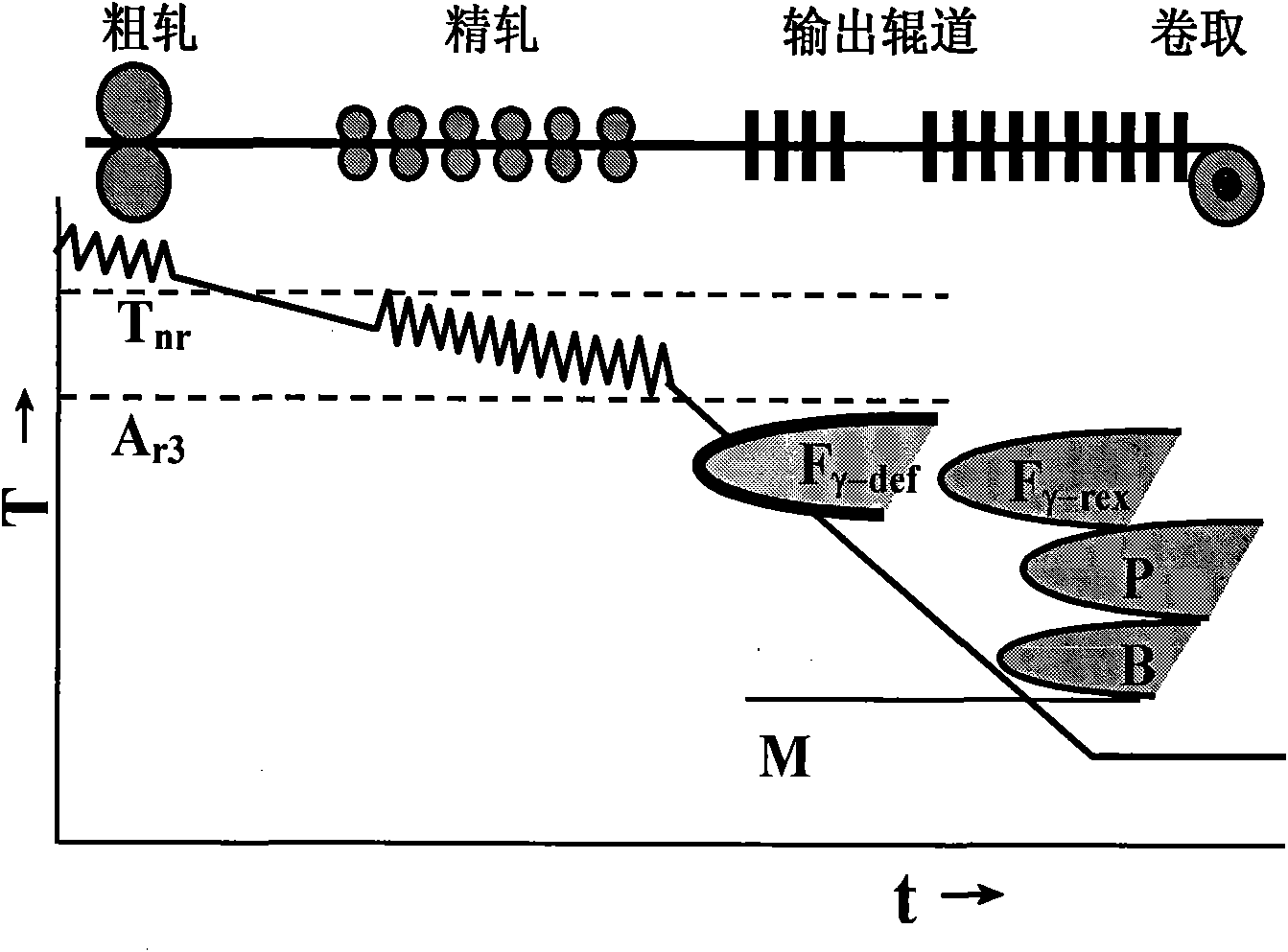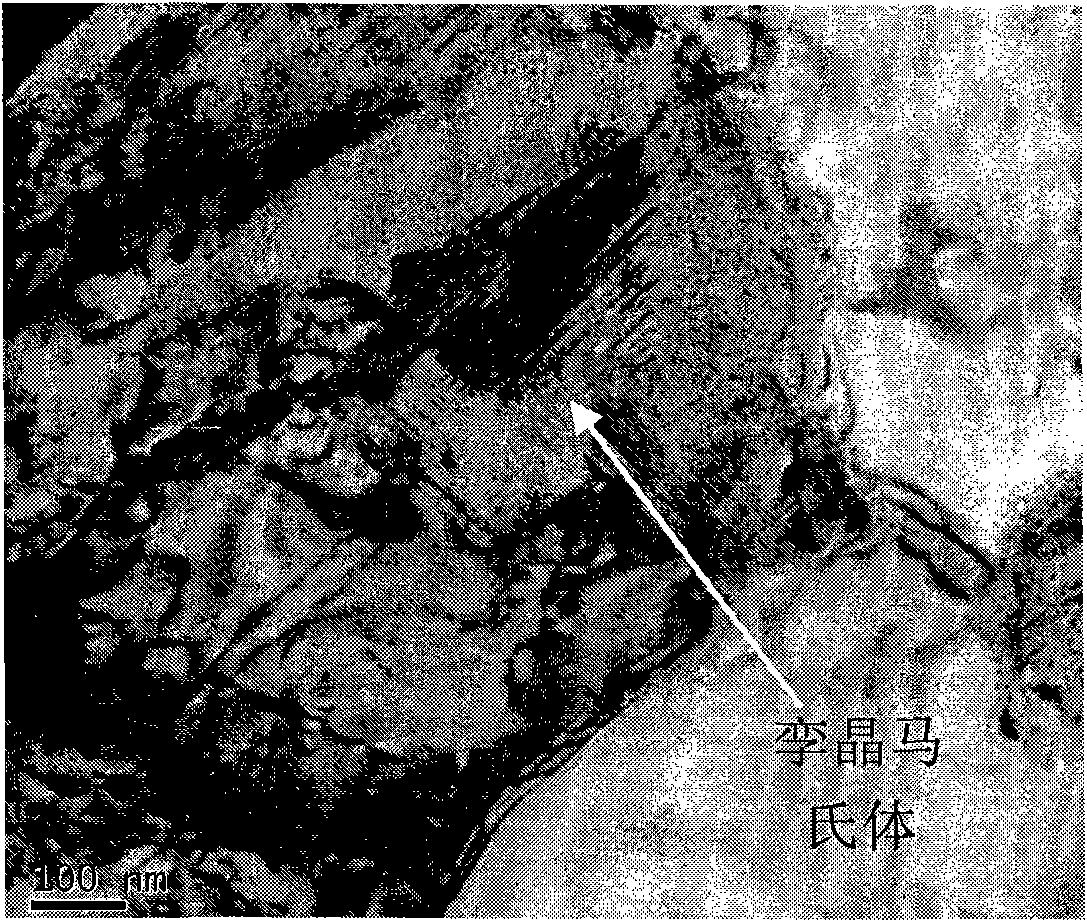Ultrafine grained hot rolled dual-phase steel with tensile strength of above 750MPa and manufacturing method of plate thereof
A hot-rolled dual-phase steel, tensile strength technology, applied in the field of steel rolling
- Summary
- Abstract
- Description
- Claims
- Application Information
AI Technical Summary
Problems solved by technology
Method used
Image
Examples
Embodiment 1
[0060] The chemical composition of the experimental steel A is shown in Table 1. The initial thickness of the billet is 60 mm, and the thickness of the finished product is 3 mm. In order to completely dissolve the carbonitrides of Nb and Ti, the blank was heated to 1200°C in a box-type resistance furnace for 1 hour and then rolled and deformed 9 times. The deformation system is shown in Table 2. The rolling process is carried out on a Φ450×450 two-roll reversing hot rolling experimental unit. Continuous cooling is adopted after final rolling, and the coiling temperature is lower than 350°C. The cooling process parameters are shown in Table 3. The mechanical properties of the steel plates are listed in Table 4.
[0061] The chemical composition (%) of table 1 embodiment 1 experimental steel A
[0062]
[0063] The rolling schedule of table 2 embodiment 1
[0064]
[0065] The temperature and cooling system of table 3 embodiment 1
[0066]
[0067] The mechanical pr...
Embodiment 2
[0073] Example 2 The chemical composition of experimental steel B is shown in Table 5. The initial thickness of the billet is 60 mm, and the thickness of the finished product is 3 mm. The billet is heated to 1200° C. for 1 hour in a box-type resistance furnace, and then rolled and deformed for 9 passes. The deformation system is the same as in Example 1. The rolling process is carried out on a Φ450×450 two-roll reversing hot rolling experimental unit. Continuous cooling is adopted after final rolling, and the coiling temperature is lower than 350°C. The cooling process parameters are shown in Table 6. The mechanical properties of the steel plates are listed in Table 7.
[0074] The chemical composition (%) of table 5 embodiment 2 experimental steel B
[0075]
[0076] Temperature regime and cooling rate of table 6 embodiment 2
[0077]
[0078] The mechanical properties and tissue volume fraction of table 7 embodiment 2
[0079]
[0080] The final structure of exper...
Embodiment 3
[0082] Example 3 The chemical composition of experimental steel C is shown in Table 8. The initial thickness of the billet is 75 mm, and the thickness of the finished product is 4 mm. The billet was heated to 1200°C in a box-type resistance furnace for 1 hour and then rolled and deformed for 9 passes. The deformation system is shown in Table 9. The rolling process is carried out on a Φ450×450 two-roll reversing hot rolling experimental unit. Continuous cooling is adopted after final rolling, and the coiling temperature is lower than 350°C. The cooling process parameters are shown in Table 10. The mechanical properties of the steel plates are listed in Table 11.
[0083] The chemical composition (%) of table 8 embodiment 3 experimental steel C
[0084]
[0085] The rolling schedule of table 9 embodiment 3
[0086]
[0087] Temperature regime and cooling rate of table 10 embodiment 3
[0088]
[0089] The mechanical properties and tissue volume fraction of table 11 ...
PUM
| Property | Measurement | Unit |
|---|---|---|
| tensile strength | aaaaa | aaaaa |
| particle size | aaaaa | aaaaa |
| particle size | aaaaa | aaaaa |
Abstract
Description
Claims
Application Information
 Login to View More
Login to View More - R&D
- Intellectual Property
- Life Sciences
- Materials
- Tech Scout
- Unparalleled Data Quality
- Higher Quality Content
- 60% Fewer Hallucinations
Browse by: Latest US Patents, China's latest patents, Technical Efficacy Thesaurus, Application Domain, Technology Topic, Popular Technical Reports.
© 2025 PatSnap. All rights reserved.Legal|Privacy policy|Modern Slavery Act Transparency Statement|Sitemap|About US| Contact US: help@patsnap.com



